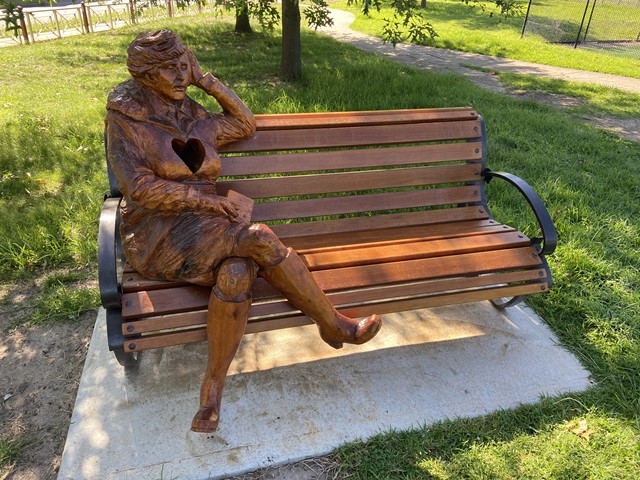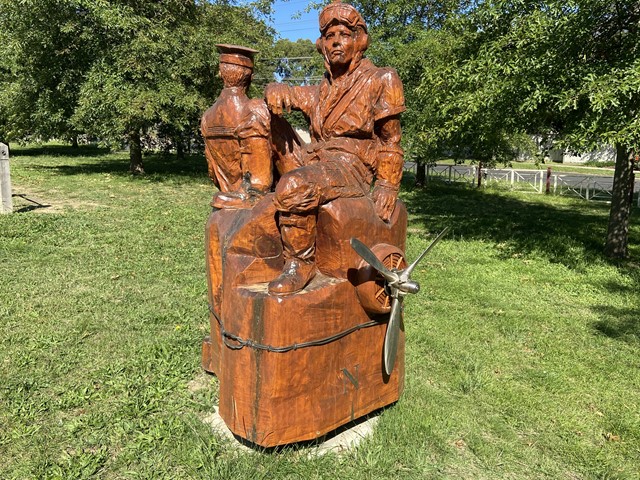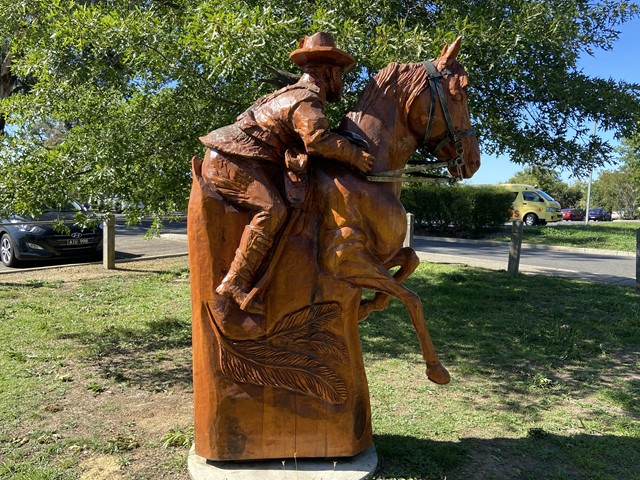Greensborough War Memorial Park Sculptures

In 2003, chainsaw sculptor Leigh Conkie crafted 12 sculptures from the stumps of cypress trees. These works of art, inspired by wartime characters, were beloved by the community. As objects of beauty and symbolism, they provided a gathering place; a place of quiet reflection. Over the years, the elements were not kind to them and they were removed in 2017 and farewelled in a ceremonial fire.
The Homefront Project began with extensive community consultation, including writing workshops for local war veterans to tell their stories of war and homecoming. These discussions and stories formed a basis for the designs for new sculptures which were installed during 2018.

'The letter' is a tribute to those left behind when loved ones go to war. She could be a wife, a girlfriend, a sister. The letter could contain devastating news, a declaration of love, the date of homecoming. The heart-shaped hole represents the pain of separation. The park bench is solid wood one end, morphing into a traditional wood and steel park bench at the other end and is a functional seat.

Pilot & Sailor - Representative of the Navy and Air Force; an aircraft propeller and a ship's propeller, both made from steel are included next to the figures of a pilot and sailor. Forged steel rope encircles the sculpture, with two knots; a square (reef) knot representing the Merchant Navy, (as seen on their insignia,) and a carrick bend representing the Royal Australian Navy. At the base of the pilot are steel markers of a compass. The pilot faces northwest, the (rough) direction of many of the global conflicts Australia has been involved with, the sailor faces towards Port Philip Bay.

Lighthorse - Australian horses had a pivotal role transporting troops and hauling supplies, equipment and ammunition during the Boer War and World War I. More than 136,000 horses were sent to war with Australian troops, and only one ever returned. Horses have been used in the Australian military up until 2008, the last mounted troop, NORFORCE worked in remote areas of Northern Australia.
Representing the Australian Lighthorse, this horse and rider leap out of a mass of wood.
Vietnam - In the face of the 'Vietnam' figure, master carver Hikaru Kodama has managed to capture the pain of war and its ongoing physical and mental burden. Hikaru has merged the legs of the soldier into the base, with hands rising up from the ground to grasp the soldier's legs; symbolic of the inescapable grip of memory. The eyepatch was inspired by veteran Bill Cantwell who was shot in the eye during the war and survived. In many of the veterans' stories, Bell UH-1 Iroquoi helicopters, known as 'Hueys' and rubber plantations featured prominently. They are both seen by the veterans as the most prominent symbols of the Vietnam War. The steel screen that curves around the soldier features an intricate design made up of these two icons; a helicopter formation and layers of rubber tree leaves.
World War I nurse - The original nurse sculpture that stood in Greensborough War Memorial Park was one of the most popular figures and deserved a replacement. This nurse carries a pile of blankets. She is without the traveling cape that is often included in depictions of Australian WWI nurses, showing she is on duty. The kookaburra that sits behind her is a symbol of home. After World War II, the kookaburra was adopted as the symbol of the War Widows Guild of Australia. Beneath the kookaburra is a sprig of gumleaves and gumnuts hand forged in steel. These symbols of Australia sit behind the nurse, suggesting she has, for the moment left home behind in order to serve.
Justin the Tracker Dog - This depicts a labrador called Justin who tracked enemy soldiers in the Vietnam war. Justin, like the other tracker dogs was given to a family in Vietnam and did not return to Australia.
Reunion - A boy running to greet his returning father.
Other sculptures include 'Modern Combat'.
For any enquiries please contact Hannes Berger at Banyule City Council (03) 9457 9913.
Photos:
Location
28 McDowell Street, Greensborough 3088 View Map
Web Links
→ Homefront Art Installation Website
→ Homefront Sculpture on Facebook








